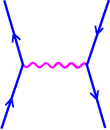Precision Electroweak Tests
![]()
My earlier research emphasized studying the effects of non-standard-model physics on precision electroweak measurements. These measurements are important for constraining and ruling out a variety of models that purport to be more fundamental than the standard model of particle physics. This work has often involved building effective field theories to describe the most important degrees of freedom at a particular energy, and relating the properties of such theories to the underlying dynamics.
Early on I studied the effects of technicolor interactions on precision electroweak measurements. Such contributions to electroweak vacuum polarizations are now conventionally described by the parameters S, and T. The S parameter describes a momentum-dependent (kinetic) mixing of the electroweak gauge bosons, while the T parameter involves isospin breaking, which splits the W and Z masses. We found that QCD-like technicolor models give large corrections to Z physics; in other words, they give contributions to S of order 1. Current measurements of S can thus rule out a large class of technicolor models.
Present data tend to give central values for S and T which are small, or negative. Most theories of non-standard physics give rise to positive values for S and T. I also showed that heavy Majorana fermions (i.e. fermions whose masses violate the conservation of fermion number) can give negative contributions to the S and T parameters
I have also examined corrections from extended technicolor theories that are complementary to S and T. The corrections from S and T are flavor blind, since they arise from vacuum polarization effects. Thus measurements of S and T are insensitive to new, flavor-dependent, physics that can appear in vertex corrections. Generally we expect the heaviest family of fermions to couple most strongly to flavor physics. Generically, extended technicolor gauge boson corrections decrease the partial width from the standard model expectation, so a large class of such models can be ruled out by current measurements. I have also looked at models where two gauge groups mix to produce the electroweak gauge group. In these models, the extended technicolor corrections increase the partial width of Z decaying to b quarks, and cancel to a large extent with the corrections from the extra electroweak gauge bosons, and thus can be consistent with current data.
Contact Info
John Terning, terning@physics.ucdavis.edu
revised June '02
![]()
